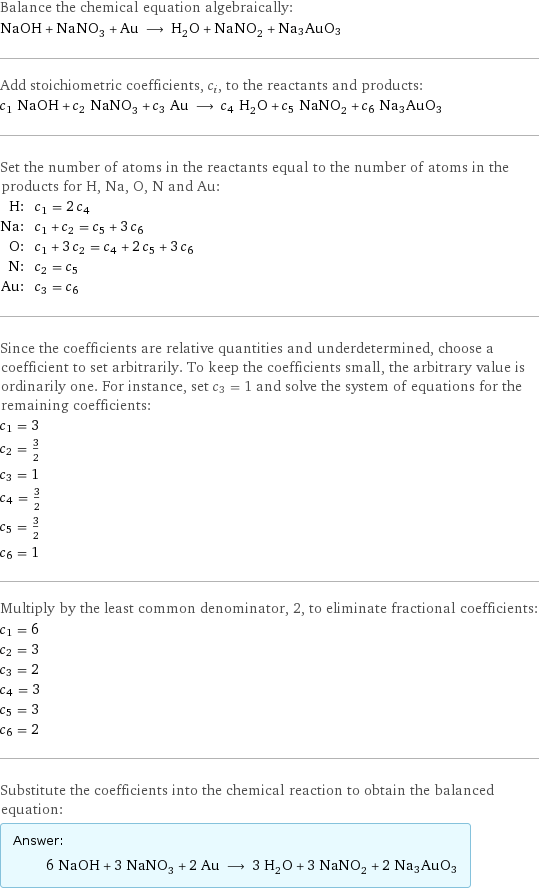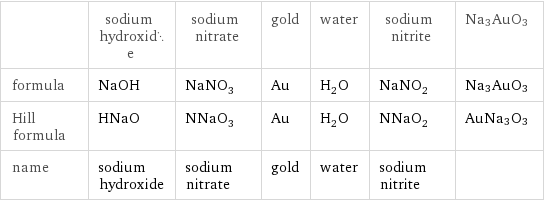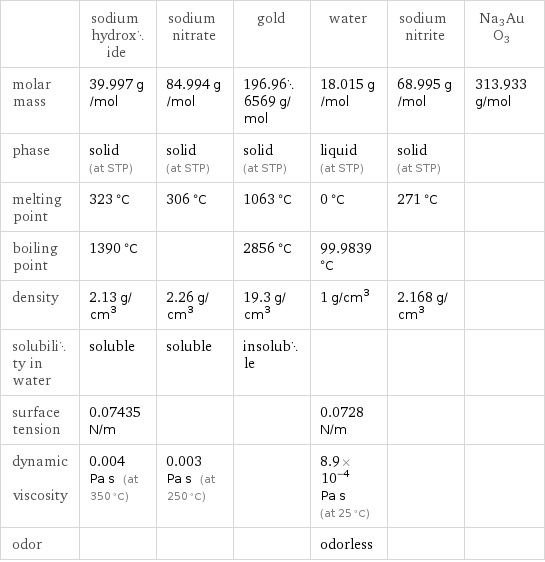Input interpretation

NaOH sodium hydroxide + NaNO_3 sodium nitrate + Au gold ⟶ H_2O water + NaNO_2 sodium nitrite + Na3AuO3
Balanced equation

Balance the chemical equation algebraically: NaOH + NaNO_3 + Au ⟶ H_2O + NaNO_2 + Na3AuO3 Add stoichiometric coefficients, c_i, to the reactants and products: c_1 NaOH + c_2 NaNO_3 + c_3 Au ⟶ c_4 H_2O + c_5 NaNO_2 + c_6 Na3AuO3 Set the number of atoms in the reactants equal to the number of atoms in the products for H, Na, O, N and Au: H: | c_1 = 2 c_4 Na: | c_1 + c_2 = c_5 + 3 c_6 O: | c_1 + 3 c_2 = c_4 + 2 c_5 + 3 c_6 N: | c_2 = c_5 Au: | c_3 = c_6 Since the coefficients are relative quantities and underdetermined, choose a coefficient to set arbitrarily. To keep the coefficients small, the arbitrary value is ordinarily one. For instance, set c_3 = 1 and solve the system of equations for the remaining coefficients: c_1 = 3 c_2 = 3/2 c_3 = 1 c_4 = 3/2 c_5 = 3/2 c_6 = 1 Multiply by the least common denominator, 2, to eliminate fractional coefficients: c_1 = 6 c_2 = 3 c_3 = 2 c_4 = 3 c_5 = 3 c_6 = 2 Substitute the coefficients into the chemical reaction to obtain the balanced equation: Answer: | | 6 NaOH + 3 NaNO_3 + 2 Au ⟶ 3 H_2O + 3 NaNO_2 + 2 Na3AuO3
Structures

+ + ⟶ + + Na3AuO3
Names

sodium hydroxide + sodium nitrate + gold ⟶ water + sodium nitrite + Na3AuO3
Equilibrium constant
![Construct the equilibrium constant, K, expression for: NaOH + NaNO_3 + Au ⟶ H_2O + NaNO_2 + Na3AuO3 Plan: • Balance the chemical equation. • Determine the stoichiometric numbers. • Assemble the activity expression for each chemical species. • Use the activity expressions to build the equilibrium constant expression. Write the balanced chemical equation: 6 NaOH + 3 NaNO_3 + 2 Au ⟶ 3 H_2O + 3 NaNO_2 + 2 Na3AuO3 Assign stoichiometric numbers, ν_i, using the stoichiometric coefficients, c_i, from the balanced chemical equation in the following manner: ν_i = -c_i for reactants and ν_i = c_i for products: chemical species | c_i | ν_i NaOH | 6 | -6 NaNO_3 | 3 | -3 Au | 2 | -2 H_2O | 3 | 3 NaNO_2 | 3 | 3 Na3AuO3 | 2 | 2 Assemble the activity expressions accounting for the state of matter and ν_i: chemical species | c_i | ν_i | activity expression NaOH | 6 | -6 | ([NaOH])^(-6) NaNO_3 | 3 | -3 | ([NaNO3])^(-3) Au | 2 | -2 | ([Au])^(-2) H_2O | 3 | 3 | ([H2O])^3 NaNO_2 | 3 | 3 | ([NaNO2])^3 Na3AuO3 | 2 | 2 | ([Na3AuO3])^2 The equilibrium constant symbol in the concentration basis is: K_c Mulitply the activity expressions to arrive at the K_c expression: Answer: | | K_c = ([NaOH])^(-6) ([NaNO3])^(-3) ([Au])^(-2) ([H2O])^3 ([NaNO2])^3 ([Na3AuO3])^2 = (([H2O])^3 ([NaNO2])^3 ([Na3AuO3])^2)/(([NaOH])^6 ([NaNO3])^3 ([Au])^2)](../image_source/97b6b91f6b295acc709ea0dcbe219c42.png)
Construct the equilibrium constant, K, expression for: NaOH + NaNO_3 + Au ⟶ H_2O + NaNO_2 + Na3AuO3 Plan: • Balance the chemical equation. • Determine the stoichiometric numbers. • Assemble the activity expression for each chemical species. • Use the activity expressions to build the equilibrium constant expression. Write the balanced chemical equation: 6 NaOH + 3 NaNO_3 + 2 Au ⟶ 3 H_2O + 3 NaNO_2 + 2 Na3AuO3 Assign stoichiometric numbers, ν_i, using the stoichiometric coefficients, c_i, from the balanced chemical equation in the following manner: ν_i = -c_i for reactants and ν_i = c_i for products: chemical species | c_i | ν_i NaOH | 6 | -6 NaNO_3 | 3 | -3 Au | 2 | -2 H_2O | 3 | 3 NaNO_2 | 3 | 3 Na3AuO3 | 2 | 2 Assemble the activity expressions accounting for the state of matter and ν_i: chemical species | c_i | ν_i | activity expression NaOH | 6 | -6 | ([NaOH])^(-6) NaNO_3 | 3 | -3 | ([NaNO3])^(-3) Au | 2 | -2 | ([Au])^(-2) H_2O | 3 | 3 | ([H2O])^3 NaNO_2 | 3 | 3 | ([NaNO2])^3 Na3AuO3 | 2 | 2 | ([Na3AuO3])^2 The equilibrium constant symbol in the concentration basis is: K_c Mulitply the activity expressions to arrive at the K_c expression: Answer: | | K_c = ([NaOH])^(-6) ([NaNO3])^(-3) ([Au])^(-2) ([H2O])^3 ([NaNO2])^3 ([Na3AuO3])^2 = (([H2O])^3 ([NaNO2])^3 ([Na3AuO3])^2)/(([NaOH])^6 ([NaNO3])^3 ([Au])^2)
Rate of reaction
![Construct the rate of reaction expression for: NaOH + NaNO_3 + Au ⟶ H_2O + NaNO_2 + Na3AuO3 Plan: • Balance the chemical equation. • Determine the stoichiometric numbers. • Assemble the rate term for each chemical species. • Write the rate of reaction expression. Write the balanced chemical equation: 6 NaOH + 3 NaNO_3 + 2 Au ⟶ 3 H_2O + 3 NaNO_2 + 2 Na3AuO3 Assign stoichiometric numbers, ν_i, using the stoichiometric coefficients, c_i, from the balanced chemical equation in the following manner: ν_i = -c_i for reactants and ν_i = c_i for products: chemical species | c_i | ν_i NaOH | 6 | -6 NaNO_3 | 3 | -3 Au | 2 | -2 H_2O | 3 | 3 NaNO_2 | 3 | 3 Na3AuO3 | 2 | 2 The rate term for each chemical species, B_i, is 1/ν_i(Δ[B_i])/(Δt) where [B_i] is the amount concentration and t is time: chemical species | c_i | ν_i | rate term NaOH | 6 | -6 | -1/6 (Δ[NaOH])/(Δt) NaNO_3 | 3 | -3 | -1/3 (Δ[NaNO3])/(Δt) Au | 2 | -2 | -1/2 (Δ[Au])/(Δt) H_2O | 3 | 3 | 1/3 (Δ[H2O])/(Δt) NaNO_2 | 3 | 3 | 1/3 (Δ[NaNO2])/(Δt) Na3AuO3 | 2 | 2 | 1/2 (Δ[Na3AuO3])/(Δt) (for infinitesimal rate of change, replace Δ with d) Set the rate terms equal to each other to arrive at the rate expression: Answer: | | rate = -1/6 (Δ[NaOH])/(Δt) = -1/3 (Δ[NaNO3])/(Δt) = -1/2 (Δ[Au])/(Δt) = 1/3 (Δ[H2O])/(Δt) = 1/3 (Δ[NaNO2])/(Δt) = 1/2 (Δ[Na3AuO3])/(Δt) (assuming constant volume and no accumulation of intermediates or side products)](../image_source/b10d57dd01edd08c62f328e9b315f646.png)
Construct the rate of reaction expression for: NaOH + NaNO_3 + Au ⟶ H_2O + NaNO_2 + Na3AuO3 Plan: • Balance the chemical equation. • Determine the stoichiometric numbers. • Assemble the rate term for each chemical species. • Write the rate of reaction expression. Write the balanced chemical equation: 6 NaOH + 3 NaNO_3 + 2 Au ⟶ 3 H_2O + 3 NaNO_2 + 2 Na3AuO3 Assign stoichiometric numbers, ν_i, using the stoichiometric coefficients, c_i, from the balanced chemical equation in the following manner: ν_i = -c_i for reactants and ν_i = c_i for products: chemical species | c_i | ν_i NaOH | 6 | -6 NaNO_3 | 3 | -3 Au | 2 | -2 H_2O | 3 | 3 NaNO_2 | 3 | 3 Na3AuO3 | 2 | 2 The rate term for each chemical species, B_i, is 1/ν_i(Δ[B_i])/(Δt) where [B_i] is the amount concentration and t is time: chemical species | c_i | ν_i | rate term NaOH | 6 | -6 | -1/6 (Δ[NaOH])/(Δt) NaNO_3 | 3 | -3 | -1/3 (Δ[NaNO3])/(Δt) Au | 2 | -2 | -1/2 (Δ[Au])/(Δt) H_2O | 3 | 3 | 1/3 (Δ[H2O])/(Δt) NaNO_2 | 3 | 3 | 1/3 (Δ[NaNO2])/(Δt) Na3AuO3 | 2 | 2 | 1/2 (Δ[Na3AuO3])/(Δt) (for infinitesimal rate of change, replace Δ with d) Set the rate terms equal to each other to arrive at the rate expression: Answer: | | rate = -1/6 (Δ[NaOH])/(Δt) = -1/3 (Δ[NaNO3])/(Δt) = -1/2 (Δ[Au])/(Δt) = 1/3 (Δ[H2O])/(Δt) = 1/3 (Δ[NaNO2])/(Δt) = 1/2 (Δ[Na3AuO3])/(Δt) (assuming constant volume and no accumulation of intermediates or side products)
Chemical names and formulas

| sodium hydroxide | sodium nitrate | gold | water | sodium nitrite | Na3AuO3 formula | NaOH | NaNO_3 | Au | H_2O | NaNO_2 | Na3AuO3 Hill formula | HNaO | NNaO_3 | Au | H_2O | NNaO_2 | AuNa3O3 name | sodium hydroxide | sodium nitrate | gold | water | sodium nitrite |
Substance properties

| sodium hydroxide | sodium nitrate | gold | water | sodium nitrite | Na3AuO3 molar mass | 39.997 g/mol | 84.994 g/mol | 196.966569 g/mol | 18.015 g/mol | 68.995 g/mol | 313.933 g/mol phase | solid (at STP) | solid (at STP) | solid (at STP) | liquid (at STP) | solid (at STP) | melting point | 323 °C | 306 °C | 1063 °C | 0 °C | 271 °C | boiling point | 1390 °C | | 2856 °C | 99.9839 °C | | density | 2.13 g/cm^3 | 2.26 g/cm^3 | 19.3 g/cm^3 | 1 g/cm^3 | 2.168 g/cm^3 | solubility in water | soluble | soluble | insoluble | | | surface tension | 0.07435 N/m | | | 0.0728 N/m | | dynamic viscosity | 0.004 Pa s (at 350 °C) | 0.003 Pa s (at 250 °C) | | 8.9×10^-4 Pa s (at 25 °C) | | odor | | | | odorless | |
Units
